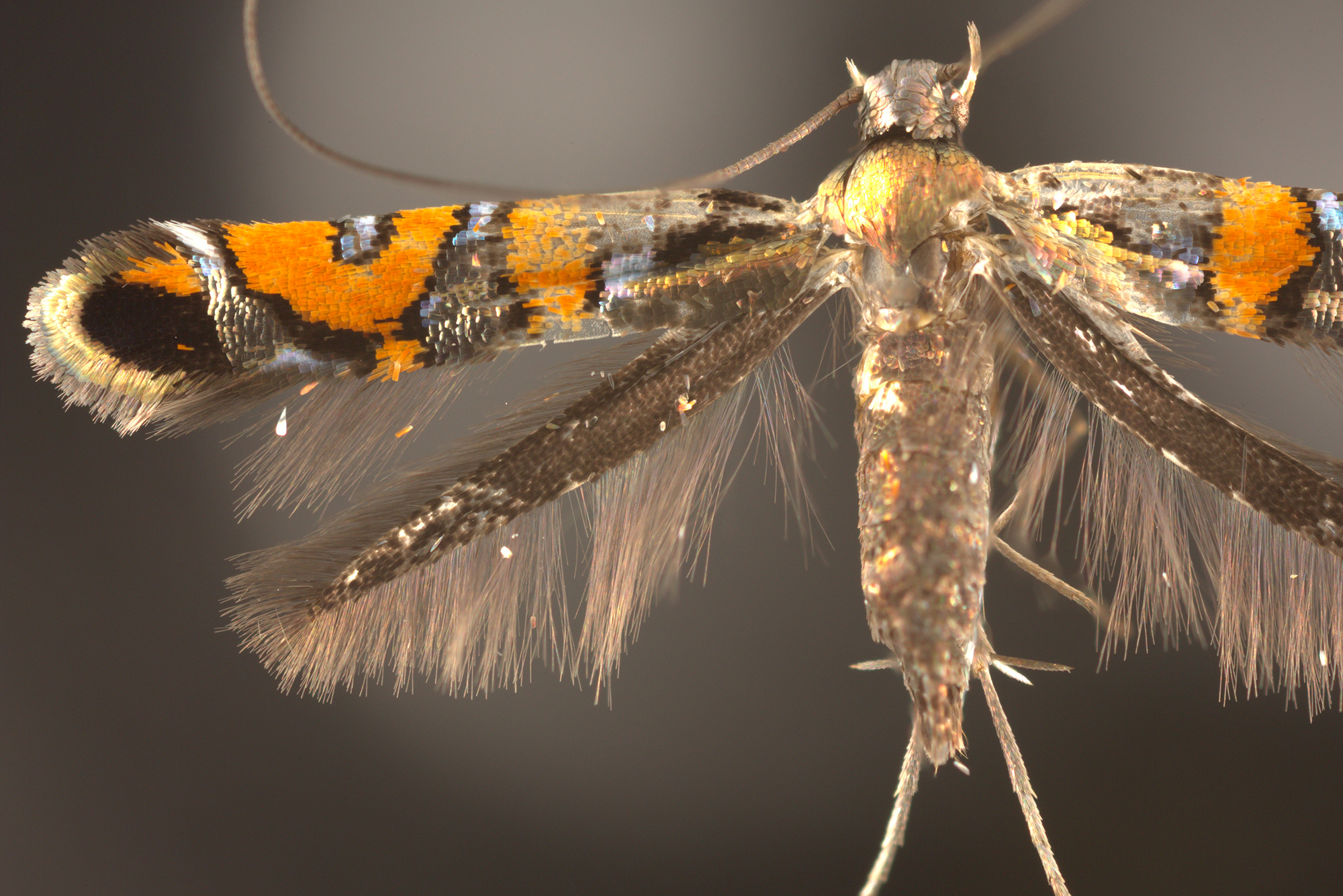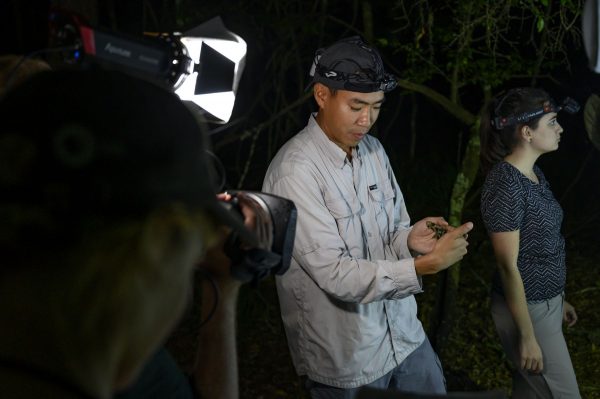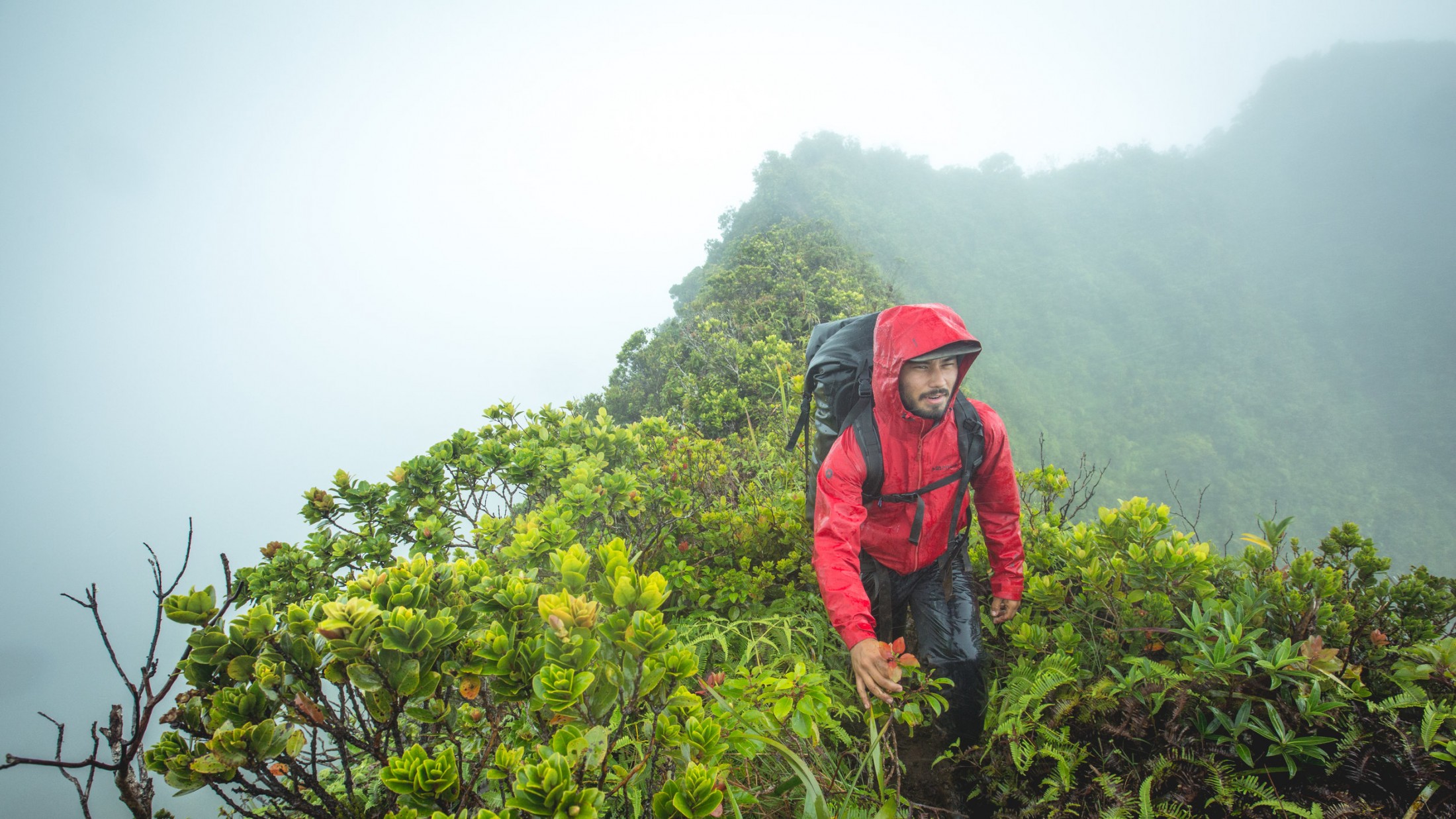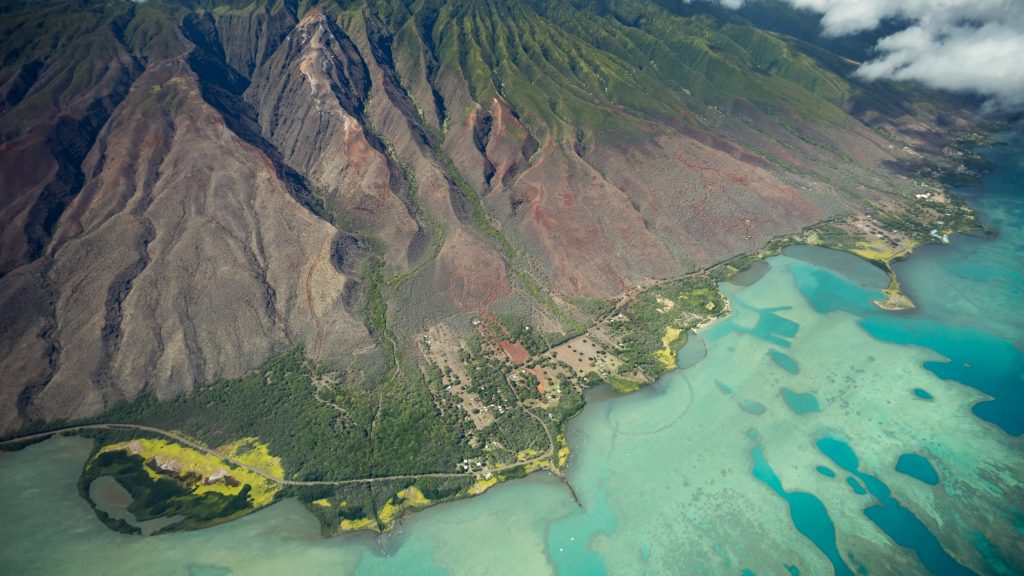Akito Kawahara was snapping pictures at a scenic outlook in Hawaii when he spotted the moth equivalent of a dodo.
An entomologist, Kawahara recognized the squiggly patterns on nearby plants as trails carved by leaf-mining caterpillars and lowered his camera to take a closer look. To his astonishment, he saw a tiny moth most experts assumed was extinct. It belonged to a genus known as Philodoria, a type of moth found only in Hawaii and one that hadn’t been documented in the wild since 1976.
“I thought, ‘Oh my God, there’s a Philodoria right here,’” said Kawahara, associate curator at the Florida Museum of Natural History’s McGuire Center for Lepidoptera and Biodiversity. “That was the beginning. It opened my eyes to the fact that at least one species had not gone extinct. Were there others?”
Kawahara’s chance sighting along a tourist footpath would kick off a hunt for the moths across all major volcanic islands of Hawaii, as well as in museum collections and back through time, resulting in the rediscovery of one of the archipelago’s oldest living lineages of native animals. Over the past eight years, Kawahara and collaborators have labored to fill gaps in our understanding of these poorly-studied insects: what they look like, where they live and what they eat. When the researchers began their work, 30 species of the slender, feathery moths were recorded in the scientific literature. That number has since grown to 51.
Now, the team is capping its project with a nearly 200-page-long study, the first to detail the natural history of all members of Philodoria, including 13 species new to science. The paper also offers a Hawaiian name for the genus, which had no known local epithet: Hunelele ‘elilau (HOO-neh-LEH-leh EH-lee-LAU), which roughly translates as a combination of “tiny flier” and “leaf excavator.”

Florida Museum photo by Chris Johns
“This is an amazing opportunity to add another key piece that deepens the Hawaiian story,” said study co-author Chris Johns, who carried out the project’s fieldwork during his doctoral studies in the Kawahara Lab. “Because of its rarity and isolated existence, Philodoria is as unique as it gets. The universe of a Philodoria species could be the size of a room.”
Many of the newly described species are named after native Hawaiian plants, places and people who have contributed to conservation on the islands, Kawahara said. One moth, Philodoria obamaorum, was christened in honor of Barack and Michelle Obama.
Shrinking habitat, disease and invasive species have wiped out much of Hawaii’s native flora and fauna, and more than 530 species on the islands are federally listed as endangered or threatened. Somehow, these micromoths, with a wingspan the length of an eyelash, have persisted.
But their restricted range and the scarcity of their host plants place them in danger of extinction. The researchers were unable to find living representatives of 10 Philodoria species known from museum specimens, and another 12 could be severely threatened, based on how scant their food sources are.
According to research led by Johns, the moths’ lineage likely dates back about 21 million years. Can they survive the next century?
Photo courtesy of Chris Johns
An insect with deep island roots
Though Philodoria is found nowhere except Hawaii, it is related to the common caterpillars that tunnel inside the leaves of tomato plants and other garden staples, creating what look like intricate sketches as they chew through the tissue. The Hawaiian branch of the leaf-mining moth family, however, has a highly specialized diet, the product of millions of years of co-evolution with the islands’ plant life, including relatives of the iconic and endangered silversword plants.
“This tiny, tiny insect has a special relationship to Hawaiian plants,” said study lead author Shigeki Kobayashi, a former postdoctoral researcher in the Kawahara Lab and now a visiting researcher at Japan’s Osaka Prefecture University.
While the diet of the genus as a whole includes 12 families of Hawaiian plants, about 80% of Philodoria species feed exclusively on a single plant genus. More than half of the plant genera they eat contain threatened or endangered species, and three-quarters of the moth species themselves are restricted to one island or volcano. The insects and their host plants are among the many examples of life unique to the Hawaiian archipelago, an incubator for evolution before the arrival of humans.
It’s a delicate system in which the balance can easily be tipped. Invasive species, in particular, can disrupt an island’s native ecosystems with mind-boggling speed, Johns said.
“Within a couple of years, a forest that is fully functioning can be completely erased and replaced with non-native species,” he said. “This can happen in places that researchers just can’t reach. A pig or goat or bird could bring an invasive plant up there. It’s a huge problem.”

Florida Museum photo by Chris Johns
Blown or rafted from parts unknown, Philodoria likely first appeared on islands that today are nearly underwater. As new islands rose from the sea, the moths colonized them, and as host plants spread and diversified, the moths followed suit. Over time, they developed intimate links with certain plant species and now depend on them for survival.
Some of their leaf-mining relatives in other parts of the world have become so intertwined with their hosts that neither species can live without the other. In the South Pacific, a local species of plant relies on another leaf-mining moth species for pollination. In turn, the moth deposits its eggs in the plants’ flowers, which will later provide food for its offspring. Whether any members of Philodoria also have this mutually beneficial relationship with their host plants was a question Kawahara hoped to answer.
“The problem is that, in some cases, there’s only one or two of the plants left on the planet,” he said. “They’re often growing off steep cliffs, very hard to find, and you have to be in the right place at the right time to see them flowering. It was hard enough to find the larvae.”
Recruiting a Philodoria whisperer
Kawahara should know. After spotting that first moth as a postdoctoral researcher 10 years ago, he spent months combing the jungle for others with no success.
He had moved halfway across the world for a faculty position at the Florida Museum when Johns knocked on his door. Johns was a recent University of Florida anthropology graduate and a plant guy in search of a moth job. As he described his previous conservation work in Hawaii, an idea began to take shape in Kawahara’s mind. Would Johns be willing to scour the rainforest for an ultra-rare moth that had eluded researchers for nearly half a century?

Florida Museum photo by Kristen Grace
Johns’ response: Game on.
“Most people think about Hawaii as this vacation spot with Mai-Tais and beaches, but it’s so much more than that,” he said. “It really all revolves around the culture, which revolves around its nature. There are so many things in Hawaii that are small and understated. The fact that Philodoria is this amazing story that no one knew about, just doing its thing – it’s an interesting reflection of what I think true Hawaii is.”
After a month on the islands, Johns appeared in Kawahara’s doorway in Gainesville with a small cooler. Inside were Philodoria.
“I was shocked,” Kawahara said. “I was convinced he was going to come back empty-handed. That was the best plane ticket I ever bought.”
The way to Philodoria is through its stomach
Johns’ strategy was to look not for the moths, but their host plants. He leaned on his ties with local conservation biologists to reach some of the islands’ most remote forests, accessible only by helicopter, four-by-four or a long hike. Once there, he searched for Philodoria’s food sources, using leads from papers published in the early 1900s and an eye already trained to distinguish native plant species from invasive ones.
It wasn’t easy. Some mountainsides were so difficult to get to, he had to be dropped off in the middle of a stream, the helicopter touching a single skid to a rock long enough for him to hop out. He would spot a piece of flagging tied to a faraway tree across a dense forest – that was the trail. Navigating it was “mostly falling,” he recalled.

Photo courtesy of Chris Johns
“You’re on a volcano in the middle of the biggest ocean in the world,” Johns said. “When you get up into these places, you really get a sense of how quiet, still and slow the entire place is. You understand the isolation so much better.”
But due to the islands’ conelike shape, Johns could look out and see the rows of hotels and condominiums packing the distant coastline.
Micromoths often play important but overlooked roles in ecosystems, and Philodoria is no exception. The connections between the moths, their host plants and their habitat are so strong that the team could use traces of leaf mines on century-old herbarium specimens to provide clues to the insects’ current whereabouts.
In one study, Johns, Kawahara and collaborators at the Bishop Museum in Honolulu discovered the dried pupae of an undescribed and possibly extinct Philodoria species on a specimen of Hesperomannia in the Bishop’s herbarium. The plant specimen was collected in 1929 on the island of Lanai where today it no longer grows. In fact, Hesperomannia has become one of the islands’ most critically endangered plants, so rare it must be pollinated by hand – perhaps an example of a host plant that has lost its moth pollinator.
“The only way we could document this particular moth-plant interaction was through museum collections,” Kawahara said. “Whoever collected those leaves may not have even realized there were pupae attached, but that’s the only record we have of that moth.”
Photo courtesy of Chris Johns
The lifecycle of Hawaii
The team also used the moths to revisit a classic evolutionary puzzle: When did plants and animals first appear in Hawaii?
On a map, Hawaii may look like a smattering of islands surrounded by ocean in all directions, but it’s actually the easternmost tip of a vast underwater mountain range that spans more than 3,600 miles, ending off the coast of Russia.
The main Hawaiian Islands – the youngest and largest – sit atop a hotspot, a single magma plume that has been birthing volcanoes for about 85 million years, which are sent on a slow westward journey by the movement of tectonic plates. The farther from the hotspot the islands travel, the more they sink and erode, finally disappearing beneath the ocean surface.
The hotspot has created an estimated 180,000 cubic miles of rock over its history. About 23 million years ago, it formed the Northwest Hawaiian Islands of Lisianski and Laysan. Once enormous landmasses rivalling the size of today’s main islands, they’re now in advanced stages of erosion: Lisianski’s highest point above sea level is a 40-foot sand dune, and Laysan – more than 800 nautical miles west of Honolulu – will likely be submerged this century.

Photo courtesy of Chris Johns
The first of the main Hawaiian Islands to appear, Kauai, surfaced about 4.7 million years ago. Many researchers believe Hawaii’s existing native plants and animals date from this period. But evidence is mounting that some, including certain kinds of insects and spiders, hail from a much earlier era, when Lisianski and Laysan were in their prime.
This is the problem with using the ages of islands to timestamp the origin of species, Kawahara said. Plants and animals can predate the islands they now inhabit.
“Islands can also go extinct,” he said. “There are a lot of gaps in our knowledge, not just in terms of insects and plants, but also in terms of island geology.”
Hawaii’s flora and fauna may have been riding a conveyor belt of islands for millions of years, gradually vanishing from older islands and moving to new ones.
Philodoria is a good example.
Using a combination of DNA evidence, island ages and studies of closely related insect groups, Johns and Kawahara estimated that the moth lineage originated more than 21 million years ago, at least 19 million years before the formation of Kauai. If accurate, this would make the moths the islands’ oldest known living lineage of native arthropods – and possibly their oldest animal lineage alive today.
This timeline and fossil pollen evidence from the moths’ host plants suggest that Lisianski and Laysan were the moths’ first Hawaiian homes.
How did such tiny insects wind up on volcanoes in the middle of the ocean?
“Plants and animals arrived in Hawaii somehow,” Kawahara said. “How they got there, when they got there and how they ended up this way are some of the most fundamentally interesting evolutionary questions.”
Florida Museum photo by Chris Johns
Small moth, big dream
The future of Philodoria depends on the conservation of its host plants, Kawahara said. Like other native Hawaiian species, such as land snails, preserving habitat and protecting against invasive species are crucial to ensuring their survival.
While the Philodoria team helped put the shimmering moths back on the map, many questions remain. No one knows exactly how the insects interact with their environment or even the identity of the group’s ancestor. But for Kawahara, publishing a compilation of all known information about the moths carries personal weight.
“This was one of my dreams,” he said. “It’s not necessarily flashy science. It’s natural history. We’re doing it for the moths. We’re doing it for conservation. We’re doing it because it’s important.”
From one Hawaiian’s perspective, the moths are essential to the islands, regardless of whether or not we ever learn their precise roles within the ecosystem.
“Our culture depends on the existence of these moths and other insects and plants,” said collaborator and conservationist Keahi Bustamante in an award-winning video created by Johns. “It’s talked about. It’s put into songs and legends. It’s documented that we respect these things and they respect us in a way that allows us to survive.”
The study was published in Zootaxa.
Funding for the research was provided by the National Science Foundation, the National Geographic Society, the Entomological Society of America, the University of Florida Entomology and Nematology Department, the Florida Museum of Natural History, the UF Tropical Conservation and Development Program, the International Biodiversity Foundation and the Society for Systematic Biologists.
Sources: Akito Kawahara, kawahara@flmnh.ufl.edu, 352-273-2018;
Chris Johns, johns.chris.a@gmail.com;
Shigeki Kobayashi, crossroad1994@hotmail.co.jp